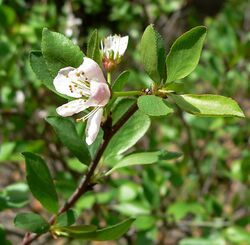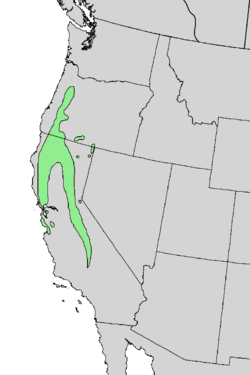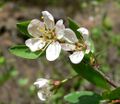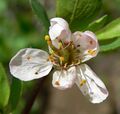Biology:Prunus subcordata
| Prunus subcordata | |
|---|---|

| |
| Leaves and flowers (detail) | |
| Scientific classification | |
| Kingdom: | Plantae |
| Clade: | Tracheophytes |
| Clade: | Angiosperms |
| Clade: | Eudicots |
| Clade: | Rosids |
| Order: | Rosales |
| Family: | Rosaceae |
| Genus: | Prunus |
| Subgenus: | Prunus subg. Prunus |
| Section: | Prunus sect. Prunocerasus |
| Species: | P. subcordata
|
| Binomial name | |
| Prunus subcordata Benth.
| |

| |
| Natural range of Prunus subcordata | |
| Synonyms | |
| |
Prunus subcordata, known by the common names Klamath plum,[1] Oregon plum, Pacific plum and Sierra plum, is a member of the genus Prunus, native to the western United States, especially California and Oregon.
Description
Prunus subcordata is an erect deciduous shrub or small tree growing to 8 meters (26 feet) in height with a trunk diameter of up to 15 centimeters (6 inches).[2] It sprouts from its roots and can form dense, spiny thickets. The bark is gray with horizontal brown lenticels, similar in appearance to that of the cultivated cherry tree. The leaves are 2.5–5 cm (1–2 in) long with a 4–15 millimeters (1⁄8–5⁄8 in) petiole, dark green, turning red before falling, and are faintly toothed. The flowers are white or pinkish, 2 cm across,[2] appearing in the spring in clusters of one to seven together. The fruit is a small, plum-like drupe, variable in appearance, 15–25 mm (5⁄8–1 in) in length, and may be red or yellow; they mature in late summer. The plums are small and tart.[3][4][5]
Varieties
P. subcordata var. kelloggii is less hairy and had larger, yellow fruits. P. subcordata var. rubicunda is a shrub with red fruits, which are relatively bitter.[5]
In addition to California and Oregon, P. subcordata var. subcordata, known as Klamath plum, is also found in Washington.[6][7]
Similar species
Prunus americana (American or wild plum) is found in the eastern United States.[2]
Taxonomy
The three main common names are related to the plum's mountain ranges and locales.
Distribution and habitat
The species is native to Northern California and from central to western and southern Oregon.[8][2] It grows in forests, most often at low elevations near the coast, but is also found in the Sierra Nevada and Cascades. It grows at altitudes of 100–1,900 m (330–6,230 ft).[3][6]
The range of P. subcordata surrounds the San Joaquin Valley, especially the western flank foothills of the Sierra Nevada range, but avoids the coast mountains of the southwest San Joaquin Valley.[8] For other Pacific coastal Prunus species, P. emarginata is also found in the Pacific Northwest states; P. fremontii and P. ilicifolia are found in coastal or mountain areas of southwest California and northern Baja California.[9][7]
Ecology
Various animals eat the fruit and thus spread the seeds.[2]
Culture
The Concow tribe call the tree gos’-i (Konkow language).[10]
See also
- Klamath Mountains
References
- ↑ "Prunus subcordata". Natural Resources Conservation Service PLANTS Database. USDA. https://plants.usda.gov/core/profile?symbol=PRSU2. Retrieved 14 October 2015.
- ↑ 2.0 2.1 2.2 2.3 2.4 Arno, Stephen F.; Hammerly, Ramona P. (2020) (in en). Northwest Trees: Identifying & Understanding the Region's Native Trees (field guide ed.). Seattle: Mountaineers Books. pp. 245-246. ISBN 1-68051-329-X. OCLC 1141235469. https://books.google.com/books?id=qDD4DwAAQBAJ.
- ↑ 3.0 3.1 Jepson Manual. University of California: Prunus subcordata
- ↑ Casebeer, MaryRuth (2004). Discover California Shrubs. Sonora, California: Hooker Press. ISBN:0-9665463-1-8
- ↑ 5.0 5.1 Flora of North America, Prunus subcordata Bentham, 1849. Sierra or Klamath or Pacific plum
- ↑ 6.0 6.1 USDA Plants Profile: Prunus subcordata. Accessed March 29, 2022.
- ↑ 7.0 7.1 Calflora taxon report, University of California, Prunus subcordata Benth. Klamath plum, Sierra plum
- ↑ 8.0 8.1 Little Jr., Elbert L. (1976). Atlas of United States Trees. 3 (Minor Western Hardwoods). US Government Printing Office. OCLC 4053799.
- ↑ Little Jr., Elbert L. (1976). Atlas of United States Trees. 3 (Minor Western Hardwoods). US Government Printing Office. OCLC 4053799.
- ↑ Chesnut, Victor King (1902). Plants used by the Indians of Mendocino County, California. Government Printing Office. p. 405. https://books.google.com/books?id=vLkUAAAAYAAJ. Retrieved 24 August 2012.
External links
- "Prunus subcordata". http://www.pfaf.org/user/Plant.aspx?LatinName=Prunus+subcordata.
- United States Department of Agriculture Plants Profile for Prunus subcordata (Klamath plum)
- Lady Bird Johnson database, University of Texas, Klamath Plum
- CalPhotos photo gallery, University of California
Wikidata ☰ {{{from}}} entry
 |





